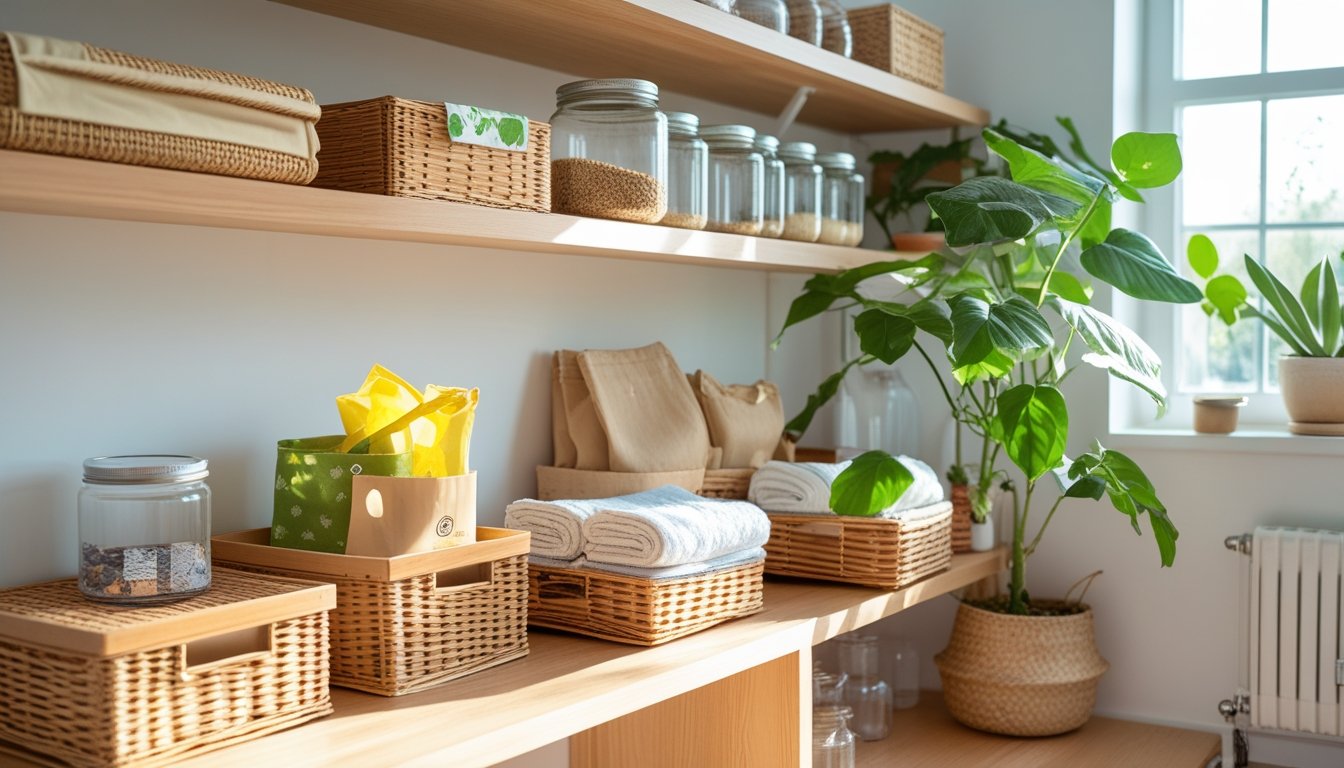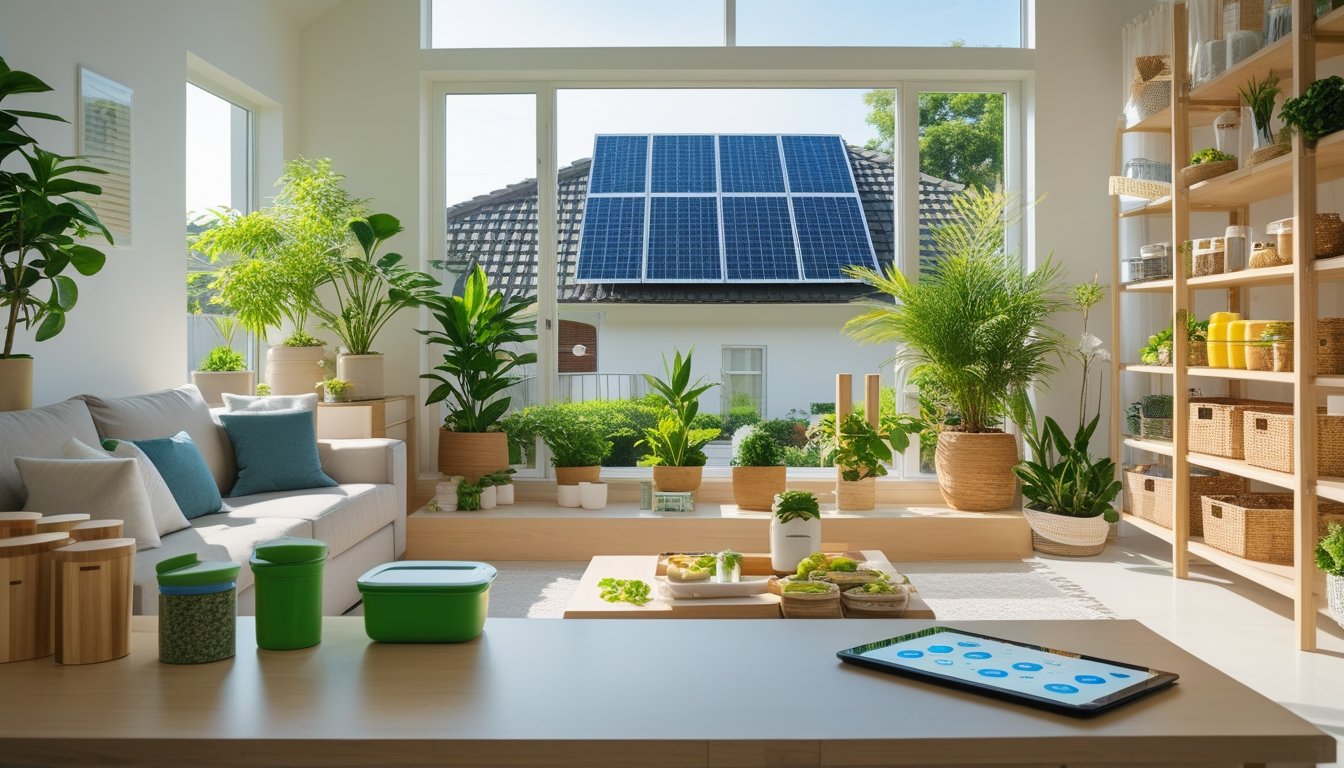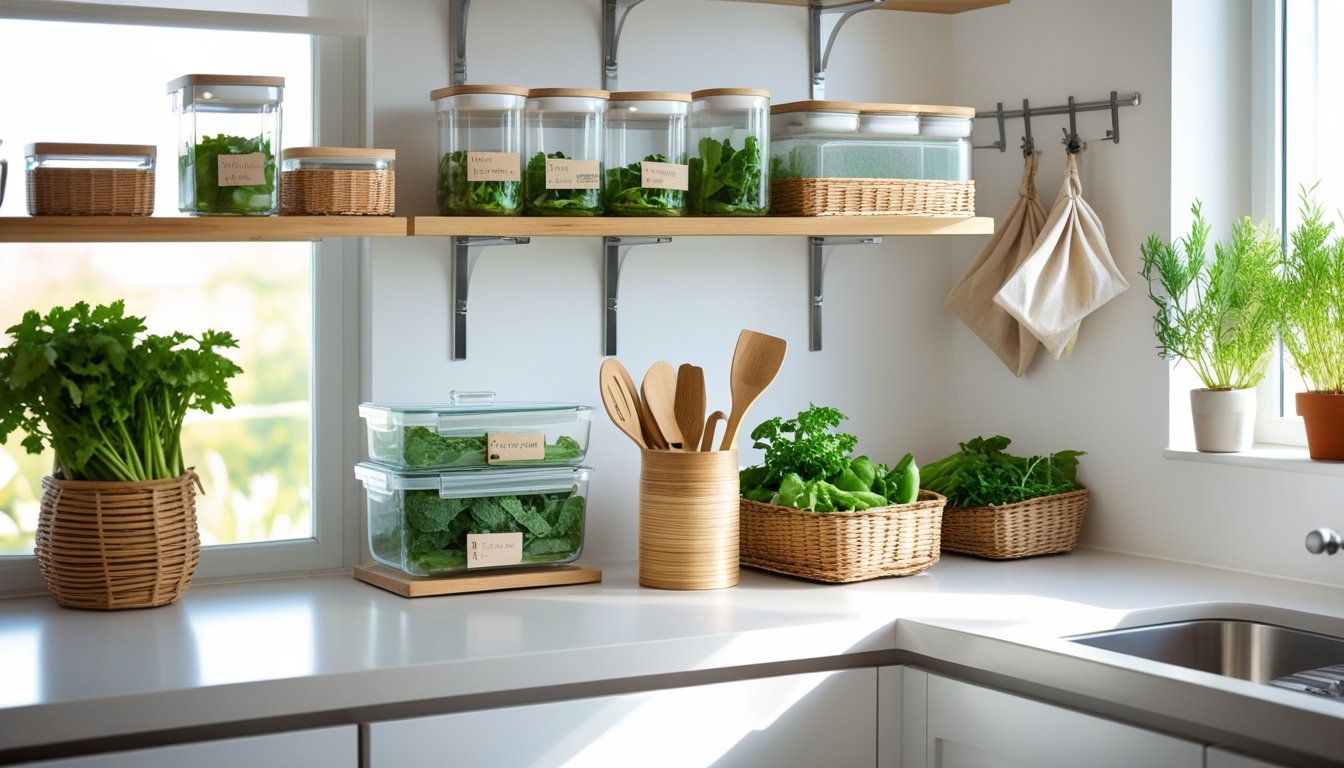Late updated: 14 Jul 2025 18:07
Written by: Sarah Hollister
Eco-Friendly Home Organising Hacks: Sustainable Solutions for a Clutter-Free Space
Venturing into the world of eco-friendly home organisation not only helps in maintaining a clutter-free living space but also greatly contributes to a sustainable lifestyle. In a time where sustainability is gaining momentum, embracing green organising habits goes a long way in reducing waste and repurposing items. Our focus is on transforming your home into a more sustainable space by implementing practical, eco-friendly strategies.

We'll explore some ingenious hacks that make use of items you already have or can easily upcycle. Whether it's repurposing an old juice bottle into a handy plastic bag dispenser or using natural cleaning products, these methods are simple yet effective. The goal is to foster an organised home without compromising the health and well-being of our planet.
A well-organised home that prioritises sustainability opens doors to additional benefits, such as improved energy efficiency and reduced waste. This approach to home organisation isn't just about aesthetics; it's about creating a healthier environment for us all to live in. Ready to join us on this journey toward a greener lifestyle?
Key Takeaways
- Eco-friendly organising promotes sustainability and minimalism.
- Simple, practical hacks can lead to significant environmental benefits.
- Focusing on reuse and recycling reduces clutter and waste.
Core Eco-Friendly Home Organising Hacks
Adopting eco-friendly practices in home organisation can significantly reduce waste and promote a more sustainable lifestyle. Let's explore some core hacks that focus on sustainable storage, responsible decluttering, recycling, and creative repurposing of household items.
Sustainable Storage Solutions and Materials
Incorporating sustainable storage solutions is key to maintaining an eco-friendly home. Opt for materials like bamboo, recycled metal, or reclaimed wood when selecting storage products. These alternatives are not only durable but also minimise environmental impact.
Use baskets or boxes made from natural fibres to organise various household items. Glass jars are excellent for pantry storage, ensuring that foods remain visible and fresh. When we choose eco-conscious materials, we contribute to waste reduction and a sustainable lifestyle.
Decluttering Responsibly and Mindful Organising
Decluttering can be both a mindful and an environmentally conscious activity. We should begin by sorting items based on their utility and sentimental value. Donate or *sell gently used items instead of discarding them. This not only reduces landfill waste but also supports those in need.
Mindful organising involves being proactive about our consumption habits. When we purchase items, we should consider their lifespan and environmental impact. This practice fosters an eco-friendly home and encourages a sustainable lifestyle over time.
Recycling and Composting Systems at Home
Setting up efficient recycling and composting systems are crucial steps towards a greener home. Label bins clearly for each type of recyclable material, such as paper, plastic, and glass, to encourage proper disposal. It's essential to stay informed about local recycling guidelines, as these can vary.
A composting system in the kitchen or garden can effectively eliminate food waste. By transforming organic waste into nutrient-rich soil, we can benefit our gardens and reduce overall household waste. Composting is a practical eco-friendly practice that can have long-lasting benefits on our environment.
Repurposing and Upcycling Household Items
Repurposing and upcycling are creative ways to reduce waste and enhance home organisation. Transform old jars into candle holders or storage containers for small items like buttons or screws. Convert wooden pallets into bookshelves or garden planters, adding a touch of personal style to our spaces.
Such activities not only breathe new life into unused items but also encourage us to be inventive and resourceful. Embracing upcycling aligns perfectly with eco-friendly home organisation, fostering a sense of sustainability and responsibility in our daily lives.
Sustainable Digital, Energy, and Lifestyle Strategies

In today's world, maintaining an eco-friendly home means embracing digital solutions that reduce paper usage, upgrading energy systems for efficiency, and integrating technology like solar panels. Each strategy outlines practical ways to optimise our home environment sustainably.
Digital Organisation for a Paperless Home
Embracing a paperless lifestyle is a fundamental step towards sustainability. We can digitise documents through scanning, storing them securely in cloud services like Google Drive or Dropbox. This not only saves physical space but also allows easy access from multiple devices.
Digital note-taking apps such as Evernote and OneNote help to replace traditional notebooks. Furthermore, setting up digital invoicing and billing reduces paper wastage. Secure encrypted storage ensures our data remains safe, while e-signature tools like DocuSign eliminate the need for physical contracts, aligning with a greener living strategy.
Energy Efficiency Upgrades and Solutions
Improving energy efficiency at home is crucial. Simple changes, such as switching to LED lighting, can significantly lower energy consumption. Smart thermostats, like Nest or Hive, allow precise temperature control, reducing unnecessary heating or cooling.
Energy-efficient appliances are key investments; they lower utility bills while conserving power. Installing insulation in walls and attics helps maintain temperature, reducing dependence on heating systems. Smart power strips prevent phantom power drainage, ensuring devices are only active when needed. Collectively, these strategies create a more efficient and eco-friendly home environment.
Integrating Green Technology and Solar Panels
Integrating solar panels is a powerful way to harness renewable energy. By installing solar systems, we reduce reliance on fossil fuels and minimise our carbon footprint. Solar panels not only supply clean energy but can also lead to long-term cost savings by reducing electricity bills.
Incorporating smart home systems that work with renewable energy sources is essential. By connecting solar-integrated inverters and battery storage solutions, we further increase energy efficiency and reliability. Additionally, joining community solar projects can extend our impact beyond personal use, supporting broader ecological efforts.
Frequently Asked Questions

Incorporating eco-friendly principles into home organisation can make a difference. We tackle common queries regarding effective storage, eco-conscious materials, and sustainable practices.
What are the best ways to store reusable bags to minimise clutter?
Storing reusable bags efficiently can help reduce clutter. We recommend folding them neatly and placing them in a dedicated drawer or hanging them inside a cupboard on hooks. This keeps them accessible and out of sight.
How can one implement space-saving techniques for small home organisation?
To save space in smaller homes, we suggest using vertical storage solutions. Shelves, wall-mounted organisers, and stackable containers can maximise available space. Prioritising items you use regularly ensures that your home remains clutter-free and functional.
Which eco-friendly materials are recommended for homemade organisation labels?
For homemade labels, opting for sustainable materials like recycled paper or bamboo can be a great choice. Utilising plant-based inks also adds an eco-friendly touch. These choices ensure that even the smallest details align with sustainable ideals.
What are some effective home organisation swaps that benefit the environment?
Consider swapping plastic containers for glass or stainless steel, and replace disposable cleaning cloths with washable, biodegradable options. Using natural, reusable alternatives not only reduces waste but often proves more durable and efficient.
How can one organise a living space effectively using sustainable products?
We suggest starting with decluttering and choosing multifunctional furniture made from sustainable materials. Using reclaimed wood or recycled materials brings both functionality and eco-friendliness into the space, creating an organised and appealing home environment.
What strategies are there for maintaining an organised home using eco-friendly principles?
Regular upkeep is key. We advise establishing a routine to evaluate unused items for donation or recycling. Implementing simple habits such as returning items to their designated spots reinforces organisation, reducing the need for frequent overhauls.
